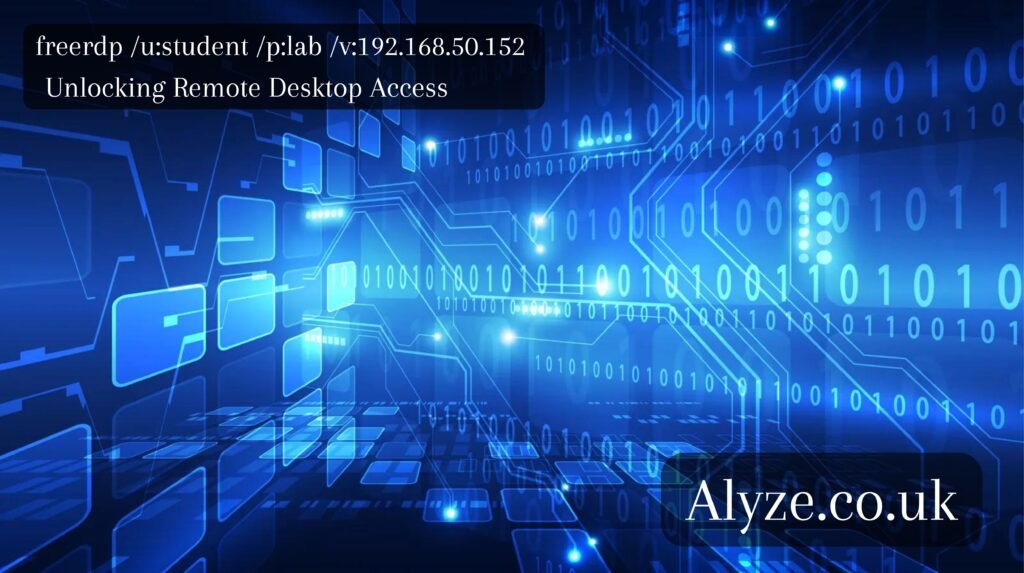Introduction
This is one great need growing in today’s fast-moving digital world, not only for enterprises and IT administrators but also for students working on different platforms. The capability of accessing a computer from afar brings flexibility, troubleshooting, and centralized management of tasks. One of the most known fashions through which one enables the facility of remote desktop access-essentially in open-source environments-is FreeRDP. This paper will dwell on one such command, containing all the components of FreeRDP: freerdp /u:student /p:lab /v:192.168.50.152, explain what is it, how to use it, and what does it mean in the bigger context of RDP technologies.
Also Read : Flikshub com : The Ultimate Digital Entertainment Platform
V gtk FreeRDP
FreeRDP is an Open Source implementation of Microsoft’s Remote Desktop Protocol, further extended with the ability to access a Windows desktop from anywhere and on any device or operating system. FreeRDP will run on a wide range of platforms and can be very versatile for developers, IT professionals, or anyone who has needs for cross-platform access. It flexes its muscles with flexibility, customization, and community-driven support not offered by proprietary or paid solutions to move in stride with the greater movement toward open-sourced software solutions.
Explanatory Command: freeRDP /u:student /p:lab /v:192.168.50.152
The next command, freeRDP /u:student /p:lab /v:192.168.50.152 will be a common FreeRDP connection string. Each part of this command has a meaning in itself. Following is an explanation of each part of the above command.
freeRDP: This is FreeRDP’s command that will open up the remote desktop client.
/u:student: The “/u” switch is used to specify the username, in this case, “student.” This identifies what identity shall be used to log into the remote desktop session.
/p:lab: This switch is to specify the password, which is “lab”. This switch will make sure that the login credential was securely transmitted for authentication.
/v:192.168.50.152: Here, the /v switch is used to tell the command about the server address or IP to which you want to connect. “192.168.50.152” here is the private IP address of the target machine from where the user will be accessing remotely.
This command directly connects the client device to the remote machine with the IP address 192.168.50.152 and authenticates it with the provided username and password.
Detailing Components of the Command
Username: (/u:student): student -This is to let FreeRDP know what user is trying to use the remote machine. Usually, in most enterprise and academic environments, the access rights are normally different depending on the username one uses.
Specifying a username means FreeRDP will make sure that access is restricted to only authorized users. 2) Password: /p:lab
The /p:lab sets the password for user authentication. Not very handy because hardcoding passwords into commands has some security concerns-for example, if your password is intercepted, that is something to be protected either with encryption or another secure way to transfer data.
Best practices offer the possibility to use complex passwords or integrate with secure password storage systems.
Server Address (/v:192.168.50.152)
For instance, 192.168.50.152 would be a private IP address, mainly used within the confines of a local network-for example, in a lab, office, or even at one’s home. This kind of address plays an important role in an environment where devices are within the same network. Such forms of addresses make access to machines relatively easy without necessarily requiring public internet addresses.
FreeRDP: Key Features and Benefits
Free and cross-platform compatibility: FreeRDP is unique in that its free code gives the ability for changes to be made in any form that a particular user sees fit. Compatibility ranges from Windows to Linux, macOS, Android, and is quite versatile over a wide range of platforms.
Cost-effective
One big advantage that FreeRDP avails is that it is free of cost, hence cheaper to afford; this may mean facilitating an organizational, educational, or individual need that wishes to create remote desktops much more cost-effectively. It would be worth its value within an educational setting where there will be a high demand for remote access, just like in the above command that states “student” as the username.
Security for Secure
Remote Access is probably one huge feature in every remote desktop software. Key security features FreeRDP claims it has include SSL encryption and support for NLA. The security is never compromised, especially when one tries to assess the sensitive machines on private networks using such commands as freerdp /u:student /p:lab /v:192.168.50.152.
FreeRDP usage scenarios : the FreeRDP commands can be used in the following scenarios, namely VDI implementation; that is, Virtual Desktop Infrastructure in learning environments.
This could be very instrumental, for instance, to the students engaging in some form of homework during remote learning sessions, especially if a certain command like freerdp/u:student has already been executed. Students do more at home using the secure FreeRDP setup and then still work on their projects, not necessarily having to be physically in the lab.
IT-Troubleshooting
As such, FreeRDP allowed the IT staff to troubleshoot, diagnose, and perform system maintenance with ease since the remote access of systems was enabled. As a fact, the command structure for FreeRDP was such that now IT staff could connect to systems and fix problems quite easily hence reducing system downtown and assuring a smooth workflow.
Collaborative Workspaces
Team members can, therefore work on various projects through the centralized machines that they can access from their remotely positioned working stations in shared or collaboration workspaces. The flexibility with which FreeRDP handles and maintains multiple sessions and machines; hence makes the tool fit for dispersed teams’ needs since one can just go about smoothly with one’s tasks at hand.
Possible Risks and Security Concerns
FreeRDP is a good tool, but there’s something about risk that one should be watching out for. Poor passwords are just one example of this. So, let’s take a look at what a weak password looks like: “lab”. An attacker can brute-force his way in. Passwords should follow security best practices; special characters, numbers, and some mix of uppercase and lowercase letters.
Unsecured networks: When connecting to machines outside a private local network, ensure it is always over secured networks. This could be innocently exposing sensitive information across an open Wi-Fi network.
Outdated versions: Remember to update FreeRDP. Most of the time, the older versions have bugs and thus can be used by malicious entities against you.
Conclusion
A simple, perhaps, but really basic example of FreeRDP in action for effective and safe remote desktop access is the following: freerdp /u:student /p:lab /v:192.168.50.152. FreeRDP, as an entity unto itself, gives agility, cross-platform, and economies of scale to IT professionals, teachers, and developers alike. All the same, much as with every form of remote desktop access, proper security and best practices should be implemented so that experiences can be seamless.
That in turn would be the answer to let FreeRDP effectively unleash the very potent possibilities of remote functioning for the person and enterprise, raising productivity further in an increasingly digital and distributed world. See More…



